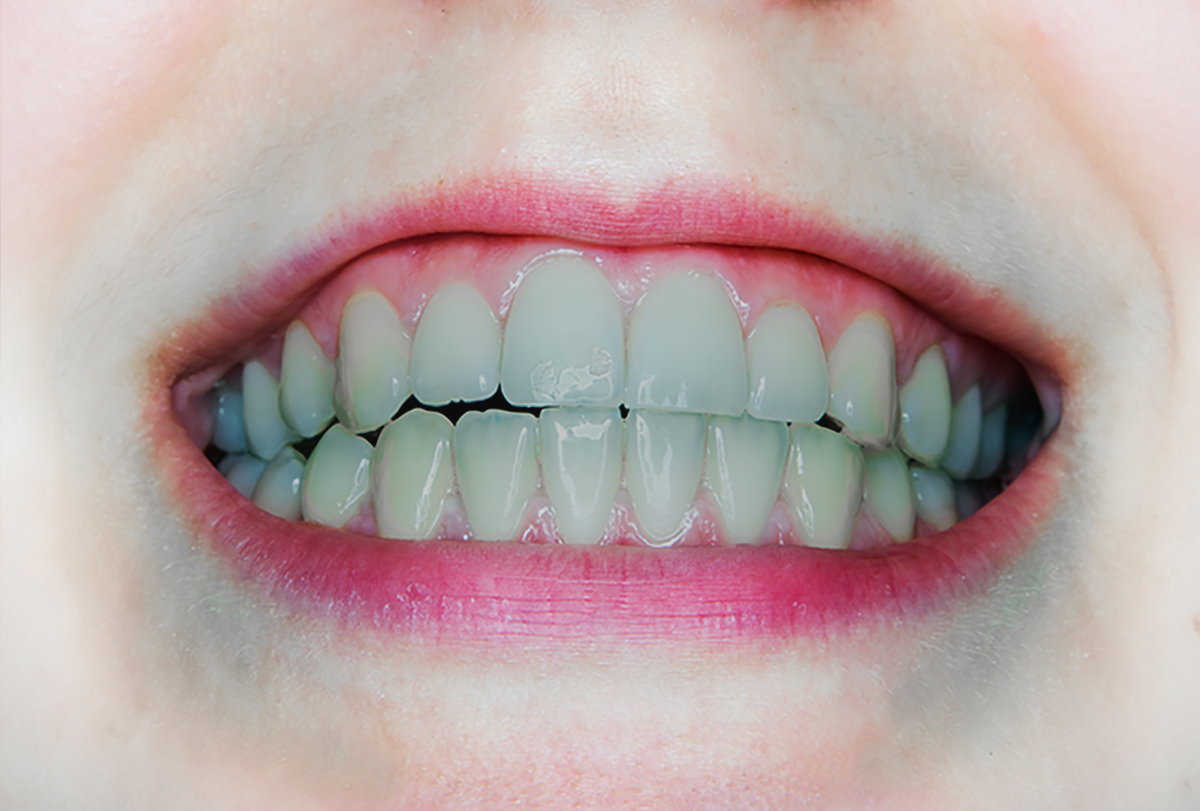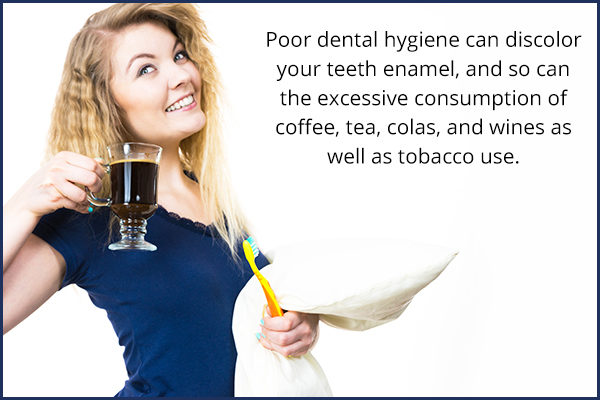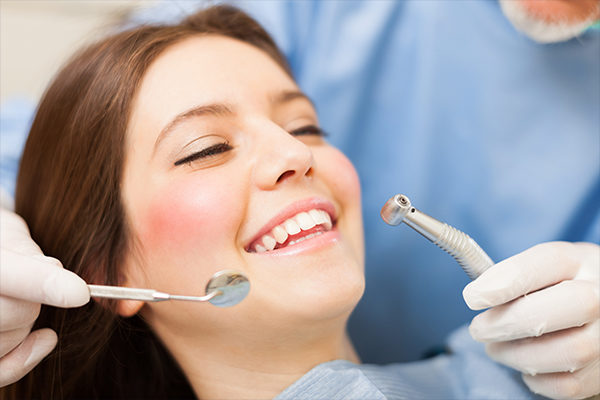In this article:
Gray teeth are discolored teeth. They stand out and can detract from a person’s smile. Discoloration in the teeth is not only in the gray spectrum but also occurs as black, brown, blue, green, orange, pink, red, and yellow tones. (1)

The appearance of a person’s teeth is important in determining their attractiveness. In people who are unhappy with the way their smile looks, about 90% state it is the color of their teeth that makes them unhappy. (1)
Causes of Tooth Discoloration

There are several causes of gray teeth, which include:
1. Aging
As you age, your teeth discolor. The enamel on the outside of the tooth thins and the dentin, which is darker, can be seen more. (2)
2. Diet
Teeth can become stained on the outside from food and drinks, such as coffee, tea, colas, and wine.
3. Tetracycline
Tetracycline is an antibiotic. When the enamel and dentin are forming (enamel is the outer layer of the tooth, dentin is just inside it), and tetracycline is given, staining of the teeth occurs. (3)
Tetracycline is used to treat many types of infections in children and adults. One of its side effects is it bonds to tissues that are becoming calcified at the time it is ingested. This results in discoloration of the baby (primary) and adult teeth. The discoloration can range from yellow to grayish brown. (4)
4. Fluorosis
Fluorosis is the exposure to too much fluoride while the teeth are forming. It can cause incorrect mineralization of the enamel and dentin. This can result in a range of consequences, from mild white spots to dark stains in the teeth. (5)
The staining can happen in children up to 8 years of age while their teeth are forming. The condition is usually caused by high amounts of fluoride added to drinking water. (5)
5. Trauma
If a tooth is violently hit by an object, it may discolor. Trauma to the primary front teeth is very common. They can become sensitive, become loose, be moved in any direction, or be knocked out.
Discoloration of the tooth is a frequent consequence of trauma to a baby tooth. (6) The gray color is believed to be the death of the pulp or nerve of the tooth. Trauma also causes graying of permanent teeth. This is due to the damage to blood vessels in the affected tooth and the decomposition of the blood within the tooth.
6. Silver nitrate
Silver nitrate is a compound that has been used in the canals of teeth that have been treated by root canal therapy. It is said to sterilize the canals. This medication can turn the tooth gray.
7. Amalgam fillings
Amalgam fillings, which are metal fillings in teeth, can make a tooth turn gray. As the filling corrodes over time, it can discolor the dentin in the tooth. This discoloration is difficult to remove by bleaching. (1)
8. Dental crowns
A dental crown that has a metal substructure with porcelain over it can look gray if the metal shows through the porcelain.
9. Orthodontic treatment
During an orthodontic treatment (braces), teeth can discolor. Forces are applied to the teeth to move them, and it is possible for the nerves in the teeth to become inflamed. This inflammation causes discoloration in the tooth, but it usually goes away on its own over time. (7)
10. Dental hygiene
Poor dental hygiene and the use of tobacco products can discolor the outside of the teeth.
Medical Treatment for Gray Teeth

Gray teeth can be treated medically in the following ways.
1. Bleaching
Teeth can be bleached in the dental office as well as at home. A bleaching gel of varying concentrations of hydrogen peroxide is placed on the teeth and remains on them for a while with or without using light to activate the solution. (8)
- Tetracycline-stained teeth can be bleached using a solution that contains various concentrations of a carbamide peroxide solution. In a study where a 10% solution was used in a tray worn at night for 6 months, many of the participants said that the improved color of their teeth stayed for 5 years. Their teeth had been stained from tetracycline. (9)
- Tooth whitening strips, which are impregnated with a hydrogen peroxide compound, have been successful in bleaching tetracycline-stained teeth. This bleaching treatment has to be continued for over 2 months. In one study, people using whitening strips showed a faster shade change after less time. (10)
2. Crowns and dental veneers
The appearance of tetracycline-stained teeth can also be improved with dental restorations such as porcelain crowns or veneers.
- A crown is a covering that is cemented over a tooth that has been drilled down to a stub. The crown can look very natural, especially without a metal substructure.
- A dental veneer is usually a thin porcelain restoration that gets bonded to the front of the existing tooth requiring very little or no drilling.
Both restorations can change the color of the visible tooth.
3. Treatment for non-vital teeth
Teeth that have had root canal treatment are called non-vital teeth. They can be bleached internally. A mixture of sodium perborate and water is placed inside the pulp chamber of the tooth, and this process is repeated until the tooth has become light enough.
Another treatment is placing a hydrogen peroxide gel in the pulp chamber, which is activated by light or heat for 5 minutes.
When the tooth is cool, the gel is removed, and the tooth is re-evaluated 2 weeks later to see if it needs additional treatment. Non-vital teeth can also be treated with a combination of internal and external bleaching techniques.
4. Changing dental restorations
If teeth are gray due to amalgam restorations or thin porcelain crowns, the restorations can be changed.
Diagnosing the Cause of Gray Teeth
The cause of gray teeth can be determined by your dentist. Your dentist will ask about your medical and dental history and will do a clinical examination of your teeth and gums.
Your dentist may also do a pulp test to see if a tooth is dead, and radiographs will be taken.
During the exam, the dentist will be able to see if a filling is corroded and is discoloring a tooth, if a tooth had root canal therapy, if a nerve is infected or dead, if tetracycline staining is present, or if a dental crown has thin porcelain.
You may have a dental cleaning to remove the stains that appear on the outside of the teeth.
Self-Care Measures to Prevent Tooth Staining

Take these steps to prevent and lighten tooth discoloration:
- Stains that form on the outside of the teeth occur because of poor oral hygiene. Brushing and flossing the teeth regularly can help prevent and remove those stains.
- The elimination of tobacco products and reducing the use of coffee, red wine, and tea will lessen the staining of teeth. Brushing soon after ingesting these products will help keep stains from forming.
- Keeping up with dental visits and professional cleanings will help keep the discolorations down.
- Avoiding tetracycline in pregnant women and young children will eliminate tetracycline staining of the teeth.
- Limiting the amount of fluoride-containing toothpaste on a child’s toothbrush to about the size of a small pea will control some of the fluorides the child ingests that is not from water.
- When playing sports, use a mouth guard to prevent damage to the teeth.
- Home bleaching kits are available at pharmacies, but the teeth should be professionally cleaned before using them.
Complications Associated With Gray Teeth
A gray tooth may be a signal that a tooth is dying. The dentist should be seen to diagnose the problem. If the tooth is dying, it can have a bacterial infection that may spread to other teeth. Usually, root canal treatment is necessary for a dying tooth.
Final Word
Gray discolored teeth are certainly a cosmetic problem that can affect your self-esteem. If a tooth suddenly becomes gray, see a dentist to avoid complications.
Good oral hygiene practices should be a part of your daily routine. Protecting your teeth with a sports guard is important during participation in sports. There are many dental restorations available if bleaching does not get the desired result.
- Was this article helpful?
- YES, THANKS!NOT REALLY


